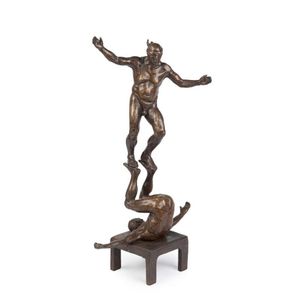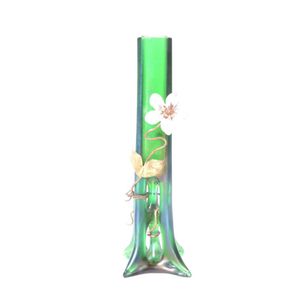Bohemian Iridescent Bud Vase with Gilt Floral Mount
You must be a subscriber, and be logged in to view price and dealer details.
Subscribe Now to view actual auction price for this item
When you subscribe, you have the option of setting the currency in which to display prices to $Au, $US, $NZ or Stg.
- Irridescent Glass - Iridescent glass has a shimmering or rainbow-like appearance due to the way it reflects light. It is created by applying a thin layer of metal oxides to the surface of the glass while it is still hot and malleable, which then creates an interference effect that produces a range of colours as the light reflects off the surface. The exact colours and patterns created by iridescent glass depend on the specific types of metal oxides used and the techniques used to apply them.
Iridescent glass was first developed in the late 19th century, and quickly became popular for use in decorative art glass and stained glass windows. Some of the most famous examples of iridescent glass were created by artists such as Louis Comfort Tiffany and his studio, who used it extensively in their distinctive lamps, vases, and other decorative objects. - Art Nouveau Period - The Art Nouveau period was a cultural movement that emerged in the late 19th century, and was characterized by its emphasis on natural forms, flowing lines, and a decorative, ornamental style. Art Nouveau was a reaction against the ornate and heavily stylized designs of the previous era, and sought to create a new, more organic aesthetic.
Art Nouveau was characterized by its use of sinuous, curving lines, as well as a focus on natural elements such as flowers, vines, and other organic shapes. Art Nouveau designers sought to create a total work of art, in which every element of a building or object was designed to be harmonious with the overall design.
Some of the most iconic examples of Art Nouveau design include the Paris Metro entrances designed by Hector Guimard, the works of the artist Alphonse Mucha, and the architecture of Victor Horta in Brussels.
The Art Nouveau period was at its peak between 1890 and 1910, but began to decline in popularity by the start of World War I. However, Art Nouveau remains an important influence on design and art to this day, and continues to be celebrated for its emphasis on natural forms and decorative style.
This item has been included into following indexes:
- Art Nouveau - glass objects 165
-
Bohemian (Czech Republic) glass wares
- various wares 461
- vases 238
Visually similar items

An 18ct. gold and diamond ring, the 0.38ct. modern round brilliant cut diamond in a rub-over mount with two modern round brilliant cut diamonds channel set to each tapering shoulder. TDW 1.18cts

A sterling silver box decorated by Cedric Flower in the style of an Indian miniature, retailed by Percy Edwards & Co., 17 and 72 Piccadilly

BARBARA McLEAN (b. 1944), Balancing Act, Bronze, signed B. McLean and dated 1990, editioned 4/12, 47 cm, The Melbourne-based sculptor Barbara McLean trained at Prahran Technical College between 1979 and 1984. From quite early in her training McLean wished

Australian pokerwork gum nut and leaf vase
